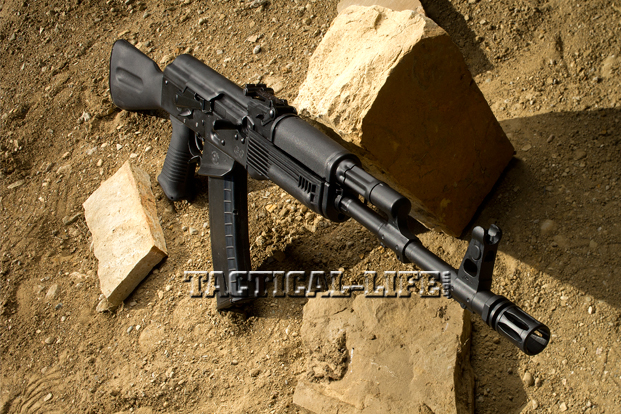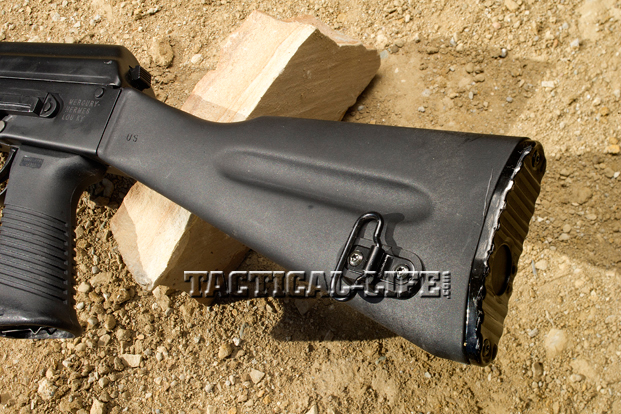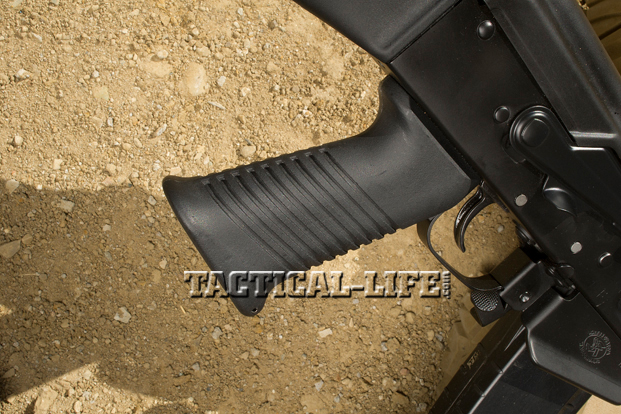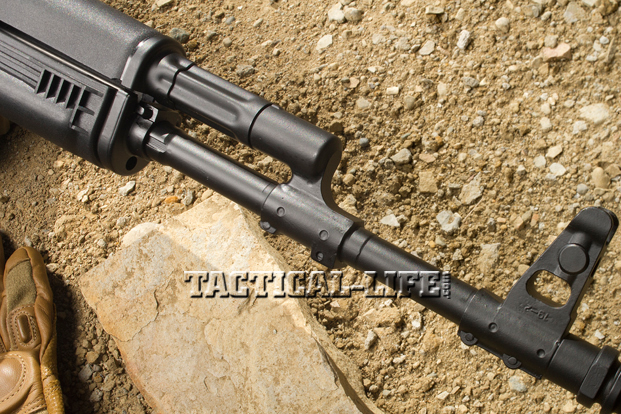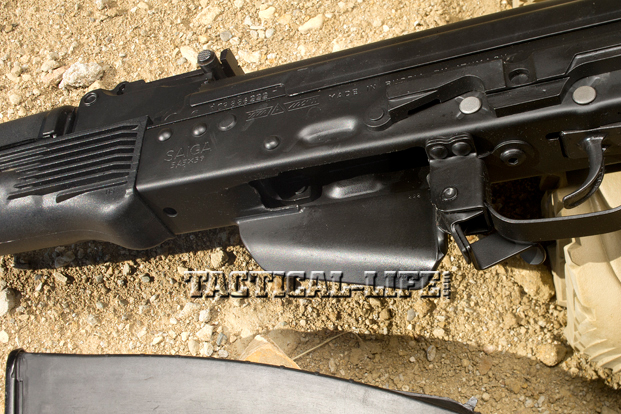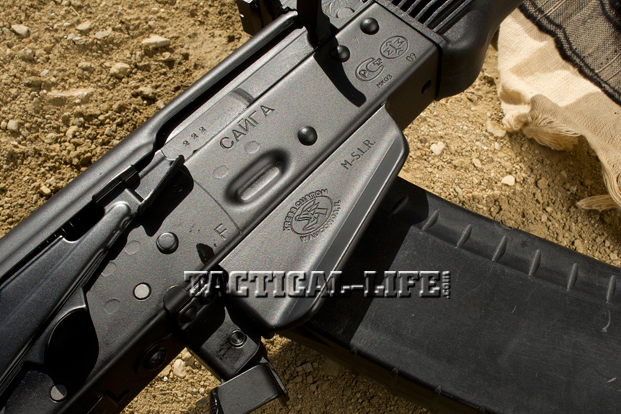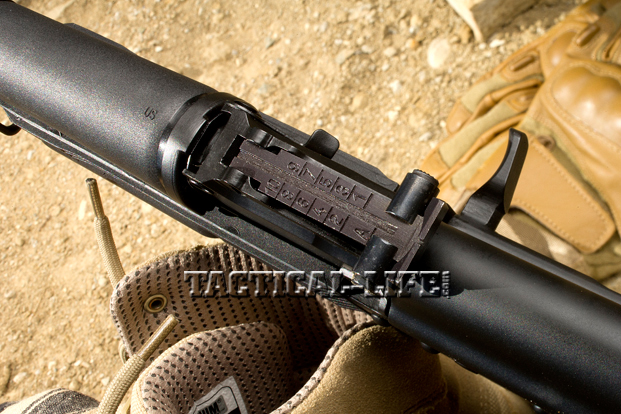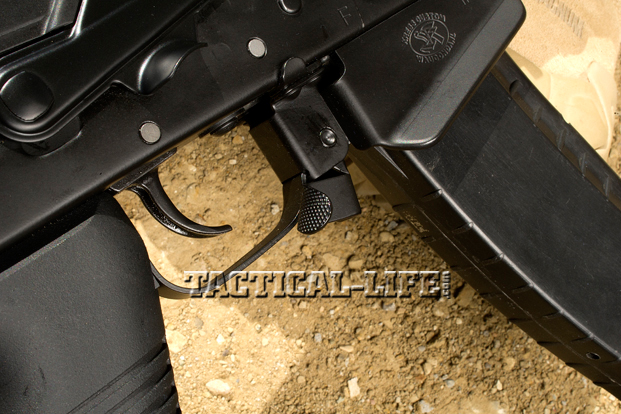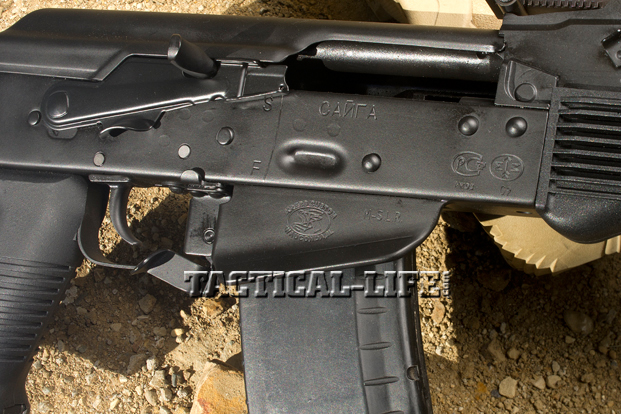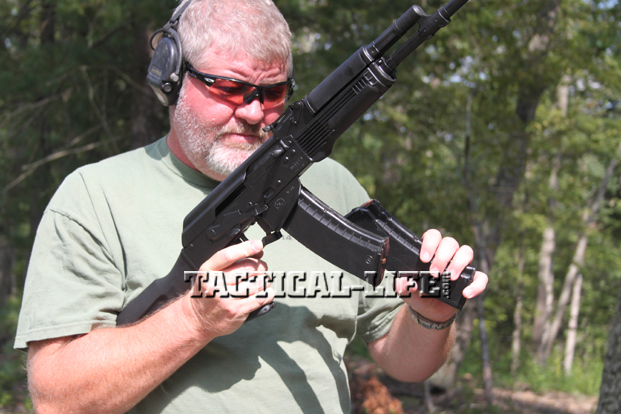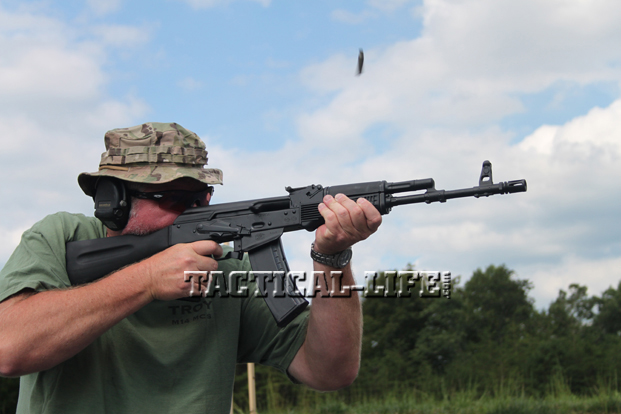The Krebs Custom Speed Load modification found on the Tactical AK represents a concerted effort to improve weapon manipulation while maintaining the AK’s ultra reliability, ruggedness and simplicity.
To the casual eye, it looks like another Kalashnikov AK. More discerning observers will identify it as an AK-74, noting from its magazine profile that it’s chambered in 5.45x39mm, not the more widespread 7.62x39mm. And an even smaller percentage of people will identify the rifle as a Krebs Custom Speed Load Tactical Rifle. (Check the flange on the receiver’s bottom.)This AK-74 starts off with a Saiga 5.45mm rifle. Krebs Custom was one of the first U.S. AK-smiths to work on Izhmash Saiga rifles and shotguns. Though modified with a sporter stock and no pistol grip to meet import requirements, the Russian Saiga is, at heart, an AK operating system. The process of returning the Saiga to the more familiar AK profile is a relatively well-known and straightforward one: Move the triggerguard forward to make room for the pistol grip, replace the fire-control group, and install your AK stock of choice.
Krebs Custom takes this a step further—a much larger step. There is a tremendous amount of fitting that goes into all Krebs Custom AKs. All receive an internal reliability check with a light honing of the bolt, bolt carrier group and guide rails. All exterior surfaces that users touch are dehorned. Even without firing a live round, the Krebs AK’s superiority over standard AKs is apparent in its smooth action, its trigger pull, the quality of its refinishing and its overall feel. The Krebs Custom Speed Load Tactical features the same great handling characteristics and reliability for which the AK is known.
Advertisement — Continue Reading Below
The Krebs AK-74 weighs 6.5 pounds, measures 36.75 inches long and has a 16.25-inch barrel. The weapon represents a return to a more traditional form, compared with the frequently encountered AKs with rails and such. (Krebs Custom is at home with such modifications; they’re just not featured on this test gun.)
Speed Load Mods
What sets apart the Krebs Custom Speed Load Tactical from other AKs? The Krebs Speed Load modification. This modification is not “smoke and mirrors” but rather a concerted effort (and application of Marc Krebs’ experience) to improve upon AK weapon-manipulation while maintaining its ultra reliability, ruggedness and simplicity. The Custom Speed Load modification consists of adding a flange on the lower right-side of the receiver, installing a magazine-ejection system, and modifying the magazine-release tab. A SAW-style pistol grip and a Krebs Custom Mk IV safety lever are also installed on the Krebs AK. The result is a cleaner, faster magazine change and better weapon-manipulation. The Krebs AK has better ergonomics. The Krebs Mk IV safety lever allows you to manipulate the safety selector with your trigger finger without changing your firing grip. This has an immediate real-world improvement on handling: The ability to keep your hand in a firing position while working the AK’s safety allows for faster first-shot reaction times. Aesthetically, the magazine-well-flange addition stands out the most. It’s a welded piece of steel that guides the alignment of the magazine on insertion into the rifle, for smoother, more efficient magazine changes.
Another component of the Krebs Speed Load is the modified magazine release, which allows the shooter to release the magazine with the trigger finger. Unlike other attempts at modifying the AK magazine release, the Krebs method still allows for a shooter to use the release in traditional, rough, AK fashion via thumb: while grasping the inserted magazine or using a new magazine to knock the empty one out of the way. Last, but not least is the magazine ejector, consisting of a small spring above the magazine release. This spring ejects the magazine free of the receiver when the release is pressed. All of the above components in the Krebs Speed Load system aid in changing the dynamics of running your AK. The system is stout and proved reliable during extensive range tests. For obvious reasons, magazine changes were a priority while evaluating the Krebs Speed Load Tactical Rifle.
Advertisement — Continue Reading Below
5.45mm Loads
The 5.45x39mm ammunition choices are beginning to expand. Wolf, Tula and Silver Bear are good sources of 5.45x39mm, with both 60- and 70-grain varieties available. Note that surplus 53-grain 5.45x39mm loads are still widely available. These are loaded with 7N6 “poison pill” bullets, which first gained notoriety in the Soviet-Afghan War. A unique design feature of the 5.45x39mm cartridge is an airspace inside the jacket at the bullet’s tip. The airspace serves to shift the bullet’s center of mass toward the rear, possibly contributing to its very early yaw when impacting a target. On impact with tissue, the bullet’s lead core (just behind the airspace) shifts forward into the space, which is particularly devastating on flesh. This shift of lead occurs asymmetrically and may be one reason for the peculiar curvature of the bullet’s path in the last half of its travel through tissue. One downside typical of most surplus ammunition is that it utilizes corrosive primers, which the Russians and other ex-Soviet Bloc states insist on using for coldweather ignition and long-term storage. A 5.45x39mm loading of special interest is the long-anticipated Hornady 60-grain V-MAX bullet mated to a steel case, which is starting to arrive on dealers’ shelves in quantity. These quality loads deliver increased accuracy in the AK-74 platform. The Wolf, Tula and Silver Bear 60-grain rounds nudged past 2,900 feet per second (fps) when fired through the Krebs AK. The 53-grain surplus ammunition clocked in at 3,000 fps.
Downrange
As I alluded earlier, no change to the AK is warranted if such change affects the gun’s efficiency or reliability. The minimal recoil impulse of the 5.45x39mm makes shooting accurately at speed very possible. The Krebs Custom Speed Load Tactical Rifle was evaluated at Echo Valley Training Center (EVTC), which hosts numerous well-known training entities every year, along with DoD personnel, and federal, state and local law enforcement agencies. Range evaluation commenced with a function test involving firing several magazines in rapid succession. A 100-yard open-sight-zero confirmation took place after functionality had been established and the rifle sights had shot on paper at 25 yards. While not unique, this is a good way to establish a baseline for reliability. Let’s face it: If an AK-type weapon does not have pristine reliability, its major attribute has been compromised. The Krebs AK functioned fine and left the handguards smoking. A steel target was routinely struck at 100 to 150 yards, with rounds sent downrange rapidly. This exhibits both the rifle’s ergonomics and overall accuracy. Accuracy with the Wolf, Tula and Silver Bear loads (60- and 70-grain) hovered in the 3- to 4-inch range at 100 yards. The Hornady V-MAX produced 2.5-inch groups. Note that this is probably more indicative of my deteriorating eyesight than of the weapon’s accuracy potential.
Other range tests consisted of completing several runs at a carbine course set up at EVTC. Several IPSC-style man-size targets are engaged from different firing positions. Multiple shots were fired at each target, and a magazine change was mandated before leaving cover. The various stages consisted of three different styles of barricade, one of which involved coming through an operable doorframe. Time was stopped by engaging two steel man-sized targets placed approximately 125 yards downrange. I find that testing any rifle in this format helps highlight the strengths or weaknesses of the weapon’s handling. Magazine changes proved more efficient once going through a couple of drill evolutions and learning to trust the Krebs Custom Speed Load modification. The urge to grip the empty AK magazine with my support hand and use my thumb to release it had to be deprogrammed. The combination of items that make up the Krebs Speed Load system—well flange, magazine ejector, modified release tab—as well as the Krebs Mk IV safety totally changes the dynamics of the weapon. No more shifting grip to manipulate a stiff safety or wrestling to insert a magazine. The ability to manipulate the Krebs Mark IV safety with the shooting hand and to eject the empty magazine significantly increased efficiency. The support hand can begin bringing a fresh magazine into play without having to be used for extracting the empty magazine from the rifle. The Krebs magazine flange guides the fresh magazine into place in a much smoother fashion by getting the magazine properly oriented in the receiver body. One still “rocks” the magazine into place, but the chance of misaligning the magazine is limited, reducing chance of fumbling during reloads—especially when under pressure.
Advertisement — Continue Reading Below
Wrap Up
The Krebs Custom Speed Load Tactical Rifle couples all the positive Kalashnikov characteristics with the lethal Russian 5.45x39mm service round. Arms aficionados will recognize and appreciate Krebs Custom’s attention to detail. The Krebs AK-74 proved reliable, more efficient in magazine changes, and accurate and controllable during rapid strings of fire. (Also, the ammunition for this weapon is more affordable.) I urge anyone who’s interested in a 5.45x39mm-chambered AK to check out Krebs Custom. For more information, visit
krebscustom.com or call 847-487-7776. ★
